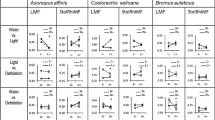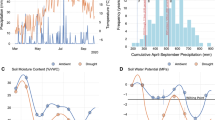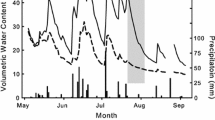Abstract
In a seasonally dry tropical region the water use efficiency (WUE) of three grasses (C3 winter annualPolypogon monspeliensis, C4 perennialDichanthium annulatum and C4 warm seasonal annualEchinochloa colonum) was evaluated during summer and winter under nine experimental conditions (3 soil moisture×3 herbage removal). Generally leaf water status and transpiration rate decreased with soil moisture stress and increased with clipping intensity. During winter the transpiration rate of Dichanthium was much lower than that of Polypogon and its own rate in summer. Both soil moisture stress and clipping intensity increased the WUE in all instances. Despite differences in photosynthetic type, growing season and life form, these grasses exhibited broadly similar positive relationships, across nine treatments for WUE: soil moisture stress, and water consumption: production. The range of WUE (g. mm−1) calculated on TNP through the nine treatments was: summer—Dichanthium 2.9–10.0, Echinochloa 2.0–6.7; winter—Dichanthium 4.3–36.3, Polypogon 1.9–12.0.
Similar content being viewed by others
References
Bannister P 1971 The water relations of heath plants from open and shaded habitats. J. Ecol. 59, 51–64.
Bannister P 1976 Physiological ecology and plant nutrition.In Methods of Plant Ecology. Ed. S B Chapman. pp 229–295. Oxford, Blackwell.
Bierhuizen J F 1976 Irrigation and water use efficiency.In Water and Plant Life, Ecol. Stud. Analysis and Synthesis. Eds. O L Lange, L Kappen and E D Schulze. Vol. 19, pp 421–431. Berlin, Springer-Verlag.
Black C C 1971 Ecological implications of dividing plants into groups with distinct photosynthetic production capacities. Adv. Ecol. Res. 7, 87–100.
Caldwell M M 1974 Physiology of desert halophytes.In Ecology of Halophytes. Eds. R J Reimold and W H Queen. pp 335–378. London, Academic Press.
Doley D and Trivett N B A 1974 Effect of low water potential on transpiration and photosynthesis in Mitchell grass (Astrebla lappacea). Aust. J. Plant Physiol. 1, 539–550.
Gardner W R and Millar A A 1973 Plant response to field water balance.In Soil Moisture and Irrigation Studies II, pp 143–153. Interantional Atomic Energy Agency, Vienna.
Gerakis P A, Guerrero F P and Williams W A 1975 Growth, water relations and nutrition of three grassland annuals as affected by drought. J. Appl. Ecol. 12, 125–35.
Green D G and Read D W L 1983 Water use efficiency of corn, sunflower and wheat with limiting soil moisture. Can. J. Plant Sci. 63, 747–749.
Jones M M and Turner N C 1978 Osmotic adjustments in leaves of sorghum in response to water deficits. Plant Physiol. 61, 122–126.
Ludlow M M 1976 Ecophysiology of C4 grasses.In Water and Plant Life, Ecol. Stud. Analysis and Synthesis. Eds. O L Lange, L Kappen and E D Schulze. Vol. 19, pp. 364–386. Berlin, Springer-Verlag.
Marx J L 1973 Photorespiration: key to plant productivity. Science, 179, 365–367.
Misra G 1980 Growth Characteristics of Certain Grasses in Response to Clipping and Moisture Stress. Ph.D. thesis, Banaras Hindu University, Varanasi.
Misra G and Singh K P 1981 Total non-structural carbohydrates of one temperature and two tropical grasses under varying clipping and soil moisture regimes. Agro-Ecosystem, 7, 213–223.
Misra G and Singh K P 1982 Effect of soil moisture and clipping stresses on the nutrient (N, P and K) concentration, uptake and use efficiency in one temperate and two tropical grasses. Plant and Soil, 69, 413–421.
Rawson H M, Bagga A K and Bremmer P M 1977 Aspects of adaptation by wheat and barley to soil moisture deficits. Aust. J. Plant Physiol. 4, 389–401.
Sandhu B S and Horton M L 1977 Response of oats to water deficit. I. Physiological characteristics. Agon. J. 69, 357–360.
Singh B P and Whitson E N 1976 Evapotranspiration and water use efficiency by soyabean lines differing in growth habit. Agron. J. 68, 834–835.
Singh J S, Singh K P and Yadav P S 1976 Ecosystem synthesis.In Grassland Ecosystems of the World: Analysis of Grasslands and Their Uses. Ed. R T Coupland. International Biological Programme. Vol. 18, London, Cambridge Univ. Press.
Slavik B (ed.) 1974 Methods of Studying Plant Water Relations. Ecol. Stud. Analysis and Synthesis, Vol. 19, Berlin, Springer-Verlag.
White L M and Brown J H 1972 Nitrogen fertilization and clipping effects on green needlegrass (Stipa viridula). II. Evapotranspiration, water use efficiency and nitrogen recovery. Agron. J. 64, 487–490.
Yadav P S and Singh J S 1977 Grassland Vegetation: Its Structure, Function, Utilization and Management. New Delhi, Today's and Tomorrow's Printers and Publishers.
Author information
Authors and Affiliations
Rights and permissions
About this article
Cite this article
Singh, K.P., Misra, G. Water-use efficiency of one C3 and two C4 grasses in response to varying soil moisture and herbage-removal levels in a seasonally dry tropical region. Plant Soil 88, 171–180 (1985). https://doi.org/10.1007/BF02182444
Received:
Revised:
Issue Date:
DOI: https://doi.org/10.1007/BF02182444




